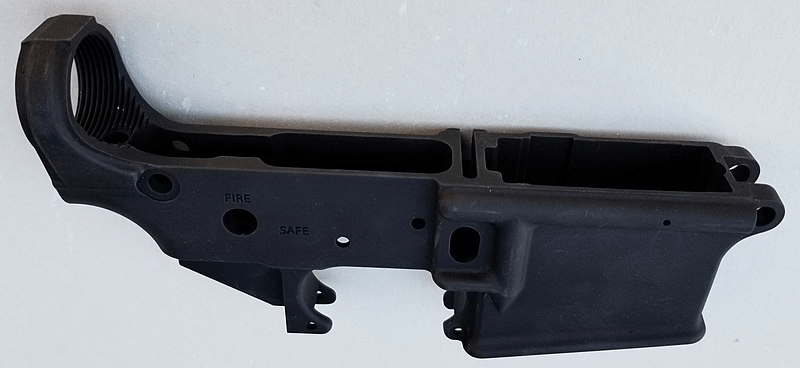What’s the Difference Between A Finished Lower and an 80 Lower?
This is a question that comes up a lot, and it’s pretty easy to answer. But it’s a good question, because it makes people think about what they can achieve with their AR, and if ever a gun was made to be modified, it’s the AR15.
An 80% lower receiver, or receiver blank as the ATF refers to it, is the incomplete version of the most essential component to the AR rifle family which can be modified or customized virtually without limit. When completed, a finished lower receiver contains the main action of the gun, and is also the serial-numbered part to make it legally defined as the firearm under US federal law. The lower receiver holds the trigger assembly including the hammer, and is the attachment point for the butt-stock.
A completed lower receiver is visually distinguished by the trigger guard which is just ahead of the detachable pistol grip, and behind the magazine well into which a magazine is inserted. The lower receiver is attached to the upper receiver by two removable pins, and if you need to disassemble the rifle for cleaning or repair of malfunctions often requires removal of these pins. Removal of the rear take-down pin allows the receivers to be opened by rotation around the forward pivot pin as a hinge.
So, the lower is an important component of the gun, and can be focus of much of the customization that goes on with it. So much so in fact, that lowers have many companies and websites dedicated to alteration of this part alone, and has also resulted in huge growth in the market of so-called 80% lower receivers sometimes called “paper weights” or “ghost guns”, but officially designated as “receiver blanks” by the ATF.
80% Finished Lower
An 80 lower is quite literally a lower receiver that has only been machined to approximately 80% completion, and thus requires finishing by the end user themselves to specifications. All that is needed to accomplish this to the standard required is a good drill press, an 80% jig, and enough DIY and workshop skills to complete the work to a sufficiently accurate standard.
Using these tools, you can finish the lower receiver that you want in a few operations, and have the satisfaction that the receiver that you end up with is exactly to your specifications. An 80% lower comes in a non-serialized form since it is legally identified as being a non-firearm by the BATF, and you are permitted to complete the work and fit it to your AR without such a number. In the eyes of the law, your 80 lower cannot possibly be used as a firearm, because it is not finished and therefore doesn’t need to be identified as such but practically, it makes sense to add some kind of identifying mark in case it gets stolen or in case you want to sell it.
100% Finished Lower
So, that is an 80 lower, but how is that different from a stripped lower receiver? Essentially, a finished lower receiver is one that has had all of the work required to form it – 100%, in fact – carried out at a manufacturer, and is ready to be fitted to your AR and is ready to go. The main difference between the stripped lower and the 80% lower is that the final 20% of the work has been done for you, and has probably been done on high precision CNC machines using professional tools and fixtures, so the finished quality is going to be much higher.
And it is this precision that can make all of the difference when it comes to almost any form of shooting. The difference between the precision of the lowers can translate into a fair bit of in-field accuracy whatever form of shooting you do, but that comes at the price of not having created the part yourself. However, depending on the skill of the operator – and the quality of the tools that they are using – this difference can actually be pretty small, almost to the point of being non-discernible.
Why Should I Get An 80% Lower?
And then there’s the cost. An 80 lower will be considerably cheaper than a stripped lower receiver, and that can be a major factor if you are carrying out a lot of customization on your AR, and the funds are running a bit low. The 80% lower receiver can save a lot of money, typically coming in at around spending $54.99 for an 80% lower, while you will typically pay around $79.99 for a stripped lower. That’s kinda simplistic because there is still your time to take into account, and the purchase of tooling, but time is immaterial for folks who like to customize, and having the tools just means that you can make more 80 lowers.
Ignoring the cost issues, choosing between an 80% lower and a stripped lower is really a choice about whether you are ready to embrace the challenge associated with a ‘do-it-yourself’ project, or purchase a lower that is already finished and is ready to be assembled.

